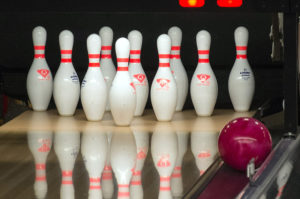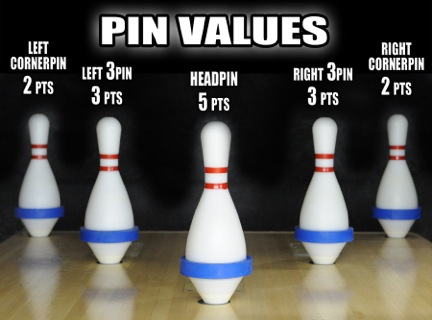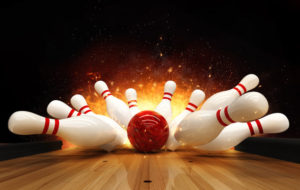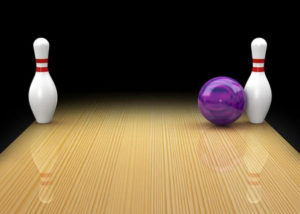Ever gone bowling and wondered why there are exactly 10 pins? Or, have you ever thought about how the number of pins might change the game altogether? If these questions bowl you over, you’re in the right place.
Contents
How Many Bowling Pins Are Usually In A Game?
In the most common form of bowling, the one we’re all familiar with, called Ten-Pin bowling, there are indeed 10 pins arranged in a triangular pattern. This version of the game is widely recognized and played globally. It’s this 10-pin setup that you’ll see in most bowling alleys, be it in the US, Europe, Asia, or anywhere else in the world.

Why Are There 10 Pins in a Bowling Game?
The choice of 10 pins originates from an old law in the state of Connecticut. Back in the 19th century, nine-pin bowling was incredibly popular but was associated with gambling and illegal activities.
In an attempt to circumvent the ban on nine-pin games, an extra pin was added, leading to the creation of ten-pin bowling. This legal loophole allowed the game to continue, and ten-pin bowling eventually rose to the prominence and popularity it holds today.
Different Number of Pins
While Ten-Pin bowling is the most globally recognized, there are versions of the game featuring different numbers of pins. Five-Pin Bowling, popular in Canada, uses only five pins. Nine-Pin Bowling is still played in parts of Europe. Each variation offers a unique challenge and requires different strategies, making bowling a versatile and fascinating sport.
Nine-Pin Bowling
As you might infer from its name, involves nine pins arranged in a diamond or square pattern.
This version of bowling is highly popular in Europe, particularly in Germany where it’s known as ‘Kegeln’.
The game is played with a fully spherical ball (without finger holes), which adds an extra dimension of challenge.
One distinguishing feature of Nine-Pin Bowling is the ‘Kingpin’. This pin, usually marked with a white head, is placed right in the middle of the arrangement and offers additional points if knocked down.
The scoring system is more complex than in Ten-Pin Bowling, with points varying based on the pins knocked down in each throw. This unique layout and scoring system make Nine-Pin Bowling a strategic and engaging variant of the traditional bowling game.

Five-Pin Bowling
In the variant known as Five-Pin Bowling, the game gets its name because, you guessed it, there are only five pins.
These pins are arranged in a V-shape, and each pin has a different point value, with the center pin being worth five points, the next pins worth three each, and the outermost pins worth two points each.
The goal is to knock down as many pins as possible in three throws, allowing for a more strategic approach than just aiming for a complete knockdown.

Different Names for Bowling Pins
Bowling pins have different names like “Skittles,” “Pins,” or “Ninepins” based on location and context, regardless of their actual number. These names come from older European games that influenced modern bowling. In some regions, “Skittles” is used interchangeably with bowling.
Does Each Bowling Pin Have Its Own Name?
The pins do not have individual names. They are commonly referred to by their positions.
For example, the pin at the very front is often called the ‘headpin’ or ‘number one pin’.
The remaining pins are numbered from two to ten, moving from left to right and front to back in the standard triangular arrangement.

Should I Try To Knock Down All The Bowling Pins?
Sure, knocking down all the bowling pins is generally the goal in most forms of bowling.
In Ten-Pin Bowling, players aim for a ‘strike’, which is knocking down all ten pins in a single throw. This is the best score you can get in one turn.
Similarly, in Five-Pin Bowling, the objective is also to knock down all the pins, but the scoring is a bit more nuanced because each pin is worth a different number of points.
However, in Nine-Pin Bowling, the ‘kingpin’ in the center is worth additional points, so precise aiming might sometimes yield a higher score than just knocking them all down.
Strike and Spare: Understanding the Scoring System of Ten-Pin Bowling
In Ten-Pin Bowling, the scoring system is straightforward yet intriguing, centered around two key terms: ‘strike’ and ‘spare’.
Strike
A ‘strike’ is when you knock down all ten pins with your first throw. It’s the most coveted outcome, earning you ten points plus the total of your next two throws as a bonus. Roll a strike, and your next two throws count double! Consecutive strikes are especially valuable. A perfect game, with 12 strikes in a row, scores 300 points, the maximum possible in Ten-Pin Bowling.

Spare
A ‘spare’ is when you knock down all ten pins using both throws in a frame. Scoring for a spare is ten points plus the number of pins knocked down on your next throw. If you roll a spare and knock down five pins on your next throw, you add 15 points to your score for the frame.
The Hardest Spare in Bowling
The most challenging spare in Ten-Pin Bowling is often referred to as the ‘Greek Church’. This setup resembles a cathedral’s architecture and occurs when pins 4, 5, 7, and 8, 10 on one side, and pins 6, 9, and 10 on the other remain standing. It’s a tricky spare that requires precision and a bit of luck to knock all the pins down in the second throw. Even seasoned bowlers consider a Greek Church spare as a notable achievement due to its difficulty.

Final Thought
From the globally recognized Ten-Pin Bowling to the unique Twelve-Pin Skittles, bowling’s versatility offers endless excitement and strategic gameplay. Just remember, regardless of the number of pins or the rules of the game, the ultimate goal is to have fun! So, next time you find yourself at a bowling alley, why not try a new variation and discover a whole new aspect of this beloved sport?

Allow me to introduce myself – I’m Eric Wilkinson, a true bowling aficionado. The world of bowling culture has always fascinated me, and I’ve made the exciting decision to share my passion through writing. As I embark on this blogging adventure, my goal is to provide fellow enthusiasts with valuable insights, tips, and captivating stories. Through my blog, I hope to ignite a deeper appreciation for the sport and foster a sense of community among fellow bowlers. Join me on this thrilling journey as we explore the vibrant world of bowling together.
